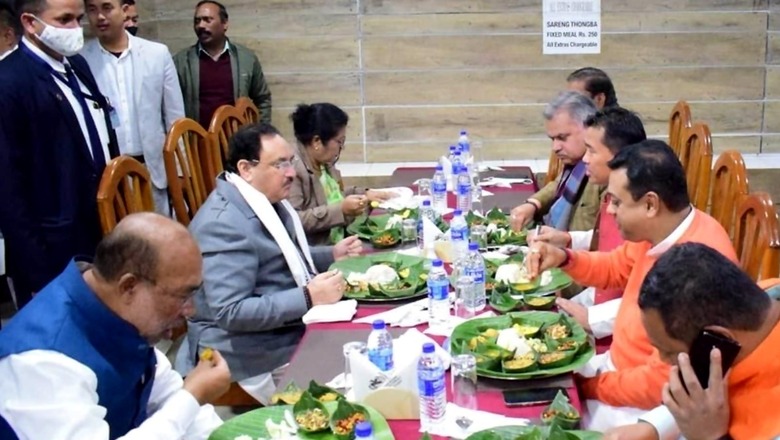
views
Politicians typically have a lot on their plate when elections are around. But Kiren Rijiju, union minister of law and BJP leader, seemed to have his priorities straight during a recent visit to poll-bound Manipur.
https://twitter.com/KirenRijiju/status/1492675531082371075?ref_src=twsrc%5Etfw
Traditional food has been integral to election campaigns and politicians— be it Priyanka Gandhi Vadra enjoying her morning phika chah (black tea) at a tea estate labourer’s house or Rahul Gandhi relishing his afternoon meal with tea garden workers during the 2021 Assam assembly elections. In the more recent Assam assembly bypolls of Mariani, chief minister Himanta Biswa Sarma enjoyed his sumptuous fish meal with tea garden workers of the constituency.
The cuisine of Manipur reflects the geographical and socio-cultural peculiarities. The culinary fare of the region is representative of the intimate connection of its people with nature. With an exciting ensemble of flavours ranging from plain to piquant, Manipuri food is an absolute delight to the senses. The food habits of the region are conditioned by the geographical as well as socio-cultural diversity. The cuisine is marked by abundant use of rice, fish and leafy green vegetables. Apart from fresh catch, fermented and dried fish called ngari is an important ingredient of a majority of dishes.
“Our rich cuisines represent culture and tradition. Our food portrays our simplicity, how we eat and like our food to taste. For anyone from North India, our food is deliciously different. The very palate differs; moreover we take special care to serve our food in special bowls made of banana leaf. You can taste our ooti, a preparation of dried peas with sodium bicarbonate; the chickpea dumpling curry. Our unique salad which we call singju; it’s a dry salad made of lotus shoot, pea shoots, black bean, black sesame and pounded gram flour. For the fish aficionados there is the ngari atouba; it’s a mashed fish curry made with herbs,” explained Sunil Sougrakpam, corporate chef at Hotel Classic, Imphal.
Sunil who did his culinary studies in London added that Kiren Rijiju in his visit to Imphal recently enjoyed the traditional Manipuri Thali prepared by him. BJP national president JP Nadda’s wife is fond of the special pickle which the Manipuri call achar. It’s made from rai powder, tomato and lemon juice.
https://twitter.com/sambitswaraj/status/1439563369275605000?lang=en
Though there are a plethora of traditional chakluk (rice hotels) in Imphal city, the Ima Market, Asia’s largest women’s market, gives one the opportunity to enjoy nga the best. Here one can have the taste of eromba, which is basically a vegetable stew with a lavish addition of fermented fish. For the vegetable lovers the iromba comes in veg form with lots of dry chilli, garlic chives, and hooker chives devoid of garlic or onion.
A typical Manipuri meal consists of the following dishes: steamed rice (which is the staple) is accompanied by kangsoi (a vegetable stew with ngari), ooti (a thick curry made of green/yellow peas, chives and beans), nga atioba thongba (a curry made of fish), kanghou (stir-fried vegetables), eromba (a mash of boiled vegetables, ngari and chilli), singju (a salad made of seasonal vegetables) and morok metpa (a paste of roasted chilies, ngari and garlic). An exotic dessert called chakhao (a pudding made of black rice) completes the meal. The most popular methods of cooking involve boiling and steaming. Oil is used only sparingly. Yet, fried items such as various kinds of boras or fritters also exist. Ingredients such as bay leaf, onion, ginger and garlic are added for enhancing flavour and aroma. A major spice which features in most dishes is the umorok or king chilli.
Unique and native to this region, vegetables such yendem (a kind of taro), kolamni (water spinach), thangjing (foxnut), koukhaa (katniss), yongchak (a variety of bitter beans), sougri (roselle leaves) are key ingredients that make the cuisine exotic.
Another defining feature of Manipuri cuisine is the use of various forms of fermented food items. Apart from fish, the repertoire of fermented foods also includes tender bamboo shoots called soibum and a dish made of fermented soya beans called hawaijar. As mentioned earlier, in Manipur, a predominant area of the landmass is covered under forests, hills and mountains and water bodies. Thus, the area of land under cultivation is low. Traditionally, the fermentation of certain food products ensured that they were available throughout the year. The process of fermentation also adds to the nutritional and pharmacological qualities of certain food items, apart from enhancing their flavour.
Sometimes, elaborate techniques are used for fermentation. For example, ganang tamdui is a traditional preparation in which mustard leaves are dried in the sun and then kept in bamboo culms until they release a pungent odour. The leaves are then pressed to extract their juice which is then boiled. This liquid is preserved and used in the preparation of a soup called tam. The dishes prepared by using fermented products are usually characterised by delightfully piquant flavours and aromas and might require some getting used to for people who have not yet been initiated into this unique cuisine.
Union defence minister Rajnath Singh on February 14, in Imphal, had a traditional Manipuri lunch at the residence of an Indian Army soldier, late Yumnam Kalleshor Kom who made the supreme sacrifice during the Kargil War in 1999. He was accompanied by Manipur chief minister N Biren Singh and BJP leader Sambit Patra.
Traditionally the food in Manipur is cooked in a large utensil ( handi) layered with mud paste at the bottom. Cooking for guests or at home is deemed auspicious and thus preceded with prayers and offerings by the cook who is usually in a dhoti. If one wishes to enjoy traditional Manipuri cuisine in an equally traditional milieu then the Peoples Canteen or the Sharma Canteen in the Polo Ground, Imphal, is the perfect destination. Food here is served in banana leaves by servers who wear dhoti and wear the sacred thread. There are a series of such hotels serving Manipuri cuisine since ages.
All’s well that ends well and likewise, a traditional Manipuri meal is never complete without the chakkhao kheer (black rice pudding).
“It is an authentic Manipuri black rice pudding, made of forbidden black rice and sugar. The black rice has a very unique flavour and is nutty in taste and texture. The kheer is rich in antioxidants, fibre, and prevents the risk of diabetes, obesity, and heart diseases,” described Rabita, owner of a traditional chakluk.
Read all the Latest Politics News and Breaking News here

















Comments
0 comment